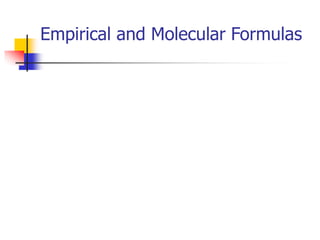
Empirical_and_Molecular_Formulas.ppt
- 1. Empirical and Molecular Formulas
- 2. Review We learned how to calculate the molar mass of compounds. Calculate the molar mass of Ca(CN)2. 1 x Ca = 1 x 40.08 g/mol = 40.08 g/mol 2 x C = 2 x 12.01 g/mol = 24.02 g/mol 2 x N = 2 x 14.01 g/mol = 28.02 g/mol TOTAL = 92.12 g/mol
- 3. Review We also learned how to determine the percentage composition of a compound. Calculate the % composition of Ca(CN)2. %Ca = (40.08)/(92.12) x 100% = 43.51% Ca %C = (24.02)/(92.12) x 100% = 26.07% C %N = (28.02)/(92.12) x 100% = 30.42% N
- 4. Empirical Formulas Molecular Formula (MF) - shows how many atoms are actually in a molecule. EXAMPLE: Glucose has the MF C6H12O6. EXAMPLE: Water has the MF H2O. O H H
- 5. Empirical Formulas Empirical Formula (EF) - shows the lowest whole-number ratio of atoms in a compound. EXAMPLE: Glucose has the EF CH2O. EXAMPLE: Water has the EF H2O. Different cmpds can have different MFs but have the same EF. EXAMPLE: NO2 and N2O4 have different MFs but the same EF (NO2).
- 6. Empirical Formulas You can discover the empirical formula of a compound if you know the % composition. Will NOT tell you which molecular formula is correct!
- 7. Empirical Formulas An unknown compound is analyzed: 15.77% carbon 84.23% sulfur Calculate the EF.
- 8. Empirical Formulas First, assume you have exactly 100 grams of the sample. Why 100 grams? Because percents become grams. In 100 grams of this compound you would have: 15.77 g C 84.23 g S
- 9. Empirical Formulas Next, change grams to moles. 15.77 g C 84.23 g S x 12.01 g C 1 mol C = 1.313 mol C x 32.07 g S 1 mol S = 2.626 mol S
- 10. Empirical Formulas The formula so far: C1.313S2.626 Divide all subscripts by the lowest one. CS2 This is the empirical formula of our mystery compound. We don’t know if it’s the correct molecular formula. Could be CS2, C2S4, C3S6, C4S8, etc...
- 11. Empirical Formulas A mystery compound has the following composition: 3.0856% hydrogen 31.604% phosphorus 65.310% oxygen What is this compound’s empirical formula?
- 12. Empirical Formulas Convert grams to moles. 3.0856 g H x = 3.0613 mol H 31.604 g P x = 1.0203 mol P 65.310 g O x = 4.0820 mol O Formula so far: H3.0613P1.0203O4.0820 Reduced: H3PO4 H g 1.00794 H mol 1 P g 30.9738 P mol 1 O g 15.9994 O mol 1
- 13. Empirical Formulas A mystery compound has the following composition: 25.940% nitrogen 74.060% oxygen What is this compound’s empirical formula?
- 14. Empirical Formulas Convert grams to moles. 25.940 g N x = 1.8520 mol N 74.060 g O x = 4.6289 mol O Formula so far: N1.8520O4.6289 Reduced: NO2.5 Double subscripts to eliminate fractions. N2O5 N g 14.0067 N mol 1 O g 15.9994 O mol 1
- 15. Molecular Formulas If we know a compound’s empirical formula and its molar mass, we can work out its molecular formula. Benzene, a common non-polar solvent, has the empirical formula CH and a molar mass of 78.12 g/mol Formula mass of CH: 13.02 g/mol How many times does this go into 78.12 g/mol? 78.12 g/mol 13.02 g/mol = 6 times Molecular formula of benzene = (CH)6 = C6H6
- 16. Molecular Formulas The empirical formula of uracil (a base found in RNA) is C2H2NO. If the molar mass of uracil is 122.09 g/mol, what is the molecular formula of uracil? Formula mass of C2H2NO: 56.05 g/mol How many times does this go into 122.09 g/mol? 122.09 g/mol 56.05 g/mol ≈ 2 Molecular formula of uracil = (C2H2NO)2 = C4H4N2O2